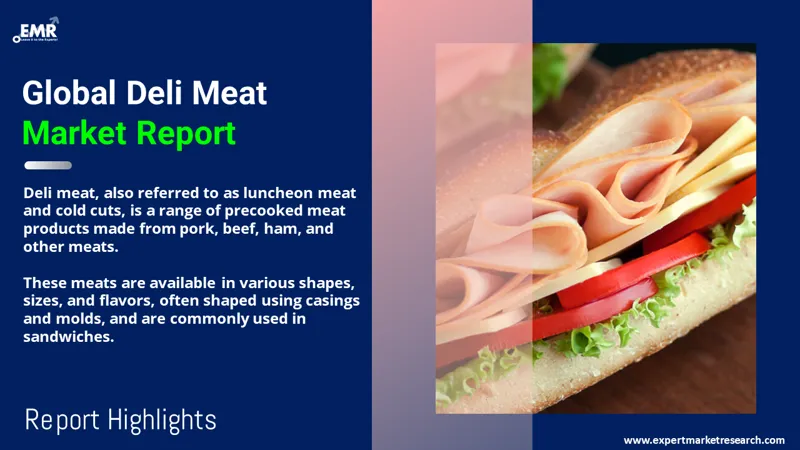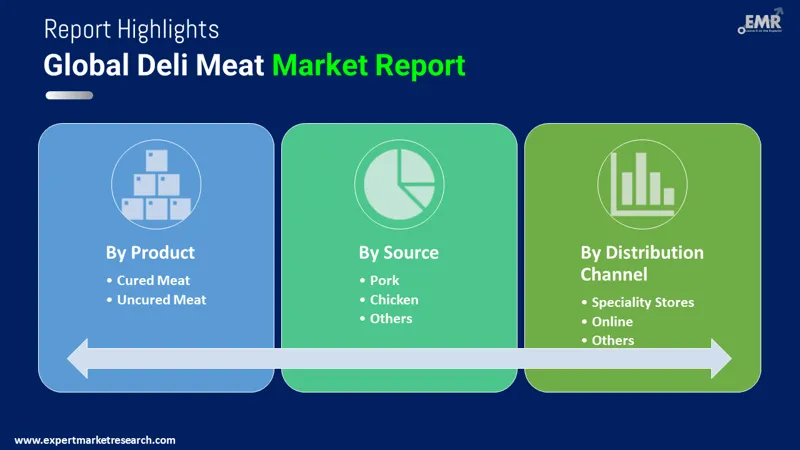
Consumer Insights
Uncover trends and behaviors shaping consumer choices today
Procurement Insights
Optimize your sourcing strategy with key market data
Industry Stats
Stay ahead with the latest trends and market analysis.
The global deli meat market size is expected to grow at a CAGR of 5.90% between 2026 and 2035. The market is being driven by the rising demand for ready-to-eat meat products and growing usage in various recipes.
Base Year
Historical Period
Forecast Period
Compound Annual Growth Rate
5.9%
2026-2035
*this image is indicative*
Deli meat, also known as luncheon meat and cold cuts, refers to precooked fresh or canned meat that is prepared from pork, beef, and ham, among others, and is available in all shapes, flavours, and sizes. They are shaped with the help of various casings and moulds and are commonly used in sandwiches.

Read more about this report - REQUEST FREE SAMPLE COPY IN PDF
The EMR’s report titled “Deli Meat Market Report and Forecast 2026-2035 offers a detailed analysis of the market based on the following segments:
Market Breakup by Product
Market Breakup by Source
Market Breakup by Distribution Channel
Market Breakup by Region

Read more about this report - REQUEST FREE SAMPLE COPY IN PDF
Supermarkets/hypermarkets accounted for a significant share in the deli meat market owing to the availability of pre-packaged meals and grab-and-go service. Various restaurants collaborate with the supermarkets in order to offer wide range of food products to their customers and to be able to buy in large volumes at reasonable costs. Meanwhile, online distribution channels for deli meat are expected to grow significantly over the forecast period as more consumers use online shopping for their groceries and can choose from a wide range of deli meats available online.
North America accounted for a large share in the deli meat market due to the widespread consumption of deli meats in sandwiches and extensive network of delis in countries such as the United States. Rising consumption of convenient food sources that do not require much additional preparation and are time efficient are further increasing the demand for deli meats. Many time-pressed consumers have shifted from having a regular meal to having pre-prepared salads and pre-packaged sandwiches. This shift in eating habits of the consumers and growing requirement for convenient meal options is additionally supporting the market growth of deli meats in North America.
The comprehensive EMR report provides an in-depth assessment of the market based on the Porter's five forces model along with giving a SWOT analysis. The report gives a detailed analysis of the following key players in the global deli meat market, covering their competitive landscape and latest developments like mergers, acquisitions, investments, and expansion plans.
Cargill Incorporated is a food company that was founded in 1865 and is headquartered in Minnesota in the United States. The company is known for processing poultry, meats, beef, and egg products for food service companies.
Hormel Foods Corporation was established in 1891 and has its headquarters in Minnesota, United States. A food processing company, Hormel packs and sells sausage, lamb, pork, beef, and chicken products to consumers.
Maple Leaf Foods, Inc. was founded in 1927 and is based in Ontario, Canada. This packaged meats company is known globally for producing meats and poultry products and providing them to retailers and food service companies.
*Please note that this is only a partial list; the complete list of key players is available in the full report. Additionally, the list of key players can be customized to better suit your needs.*
Other market players include Sysco Corporation, Deli Brands of America, Walnut Creek Foods, Nations Best Deli Meats, Newport Meat Company, Deli Meats Inc, Evans Meats & Seafood, Inc., Marisa Foods, and Boar’s Head Brand, among others.




*While we strive to always give you current and accurate information, the numbers depicted on the website are indicative and may differ from the actual numbers in the main report. At Expert Market Research, we aim to bring you the latest insights and trends in the market. Using our analyses and forecasts, stakeholders can understand the market dynamics, navigate challenges, and capitalize on opportunities to make data-driven strategic decisions.*
Get in touch with us for a customized solution tailored to your unique requirements and save upto 35%!
The market is expected to grow at a CAGR of 5.90% between 2026 and 2035.
The key drivers of the market include rising demand for convenient and ready-to-eat food products, growing availability of deli meats, and increased availability of various deli meats.
The key trends of the market are busy lifestyles, versatility of deli meat, popularity of organic meat, and experimentation with different recipes featuring deli meat.
The major regions in the market are North America, Europe, the Asia Pacific, Latin America, and the Middle East and Africa.
The primary products in the market for deli meat include cured meat and uncured meat.
The significant distribution channels for deli meat include supermarkets/hypermarkets, convenience stores, specialty stores, and online, among others.
Deli meat is a type of fresh or canned meat that is ready to serve and is prepared using pork, beef, and ham, among others.
The key players in the deli meat market are Cargill Incorporated, Hormel Foods Corporation, Maple Leaf Foods, Inc., Sysco Corporation, Deli Brands of America, Walnut Creek Foods, Nations Best Deli Meats, Newport Meat Company, Deli Meats Inc, Evans Meats & Seafood, Inc., Marisa Foods, and Boar’s Head Brand, among others.
Explore our key highlights of the report and gain a concise overview of key findings, trends, and actionable insights that will empower your strategic decisions.
| REPORT FEATURES | DETAILS |
| Base Year | 2025 |
| Historical Period | 2019-2025 |
| Forecast Period | 2026-2035 |
| Scope of the Report |
Historical and Forecast Trends, Industry Drivers and Constraints, Historical and Forecast Market Analysis by Segment:
|
| Breakup by Product |
|
| Breakup by Source |
|
| Breakup by Distribution Channel |
|
| Breakup by Region |
|
| Market Dynamics |
|
| Competitive Landscape |
|
| Companies Covered |
|
Datasheet
One User
USD 2,499
USD 2,249
tax inclusive*
Single User License
One User
USD 3,999
USD 3,599
tax inclusive*
Five User License
Five User
USD 4,999
USD 4,249
tax inclusive*
Corporate License
Unlimited Users
USD 5,999
USD 5,099
tax inclusive*
*Please note that the prices mentioned below are starting prices for each bundle type. Kindly contact our team for further details.*
Flash Bundle
Small Business Bundle
Growth Bundle
Enterprise Bundle
*Please note that the prices mentioned below are starting prices for each bundle type. Kindly contact our team for further details.*
Flash Bundle
Number of Reports: 3
20%
tax inclusive*
Small Business Bundle
Number of Reports: 5
25%
tax inclusive*
Growth Bundle
Number of Reports: 8
30%
tax inclusive*
Enterprise Bundle
Number of Reports: 10
35%
tax inclusive*
How To Order

Select License Type
Choose the right license for your needs and access rights.

Click on ‘Buy Now’
Add the report to your cart with one click and proceed to register.

Select Mode of Payment
Choose a payment option for a secure checkout. You will be redirected accordingly.
Gain insights to stay ahead and seize opportunities.

Get insights & trends for a competitive edge.

Track prices with detailed trend reports.

Analyse trade data for supply chain insights.

Leverage cost reports for smart savings

Enhance supply chain with partnerships.

Connect For More Information
Our expert team of analysts will offer full support and resolve any queries regarding the report, before and after the purchase.
Our expert team of analysts will offer full support and resolve any queries regarding the report, before and after the purchase.
We employ meticulous research methods, blending advanced analytics and expert insights to deliver accurate, actionable industry intelligence, staying ahead of competitors.
Our skilled analysts offer unparalleled competitive advantage with detailed insights on current and emerging markets, ensuring your strategic edge.
We offer an in-depth yet simplified presentation of industry insights and analysis to meet your specific requirements effectively.
Share